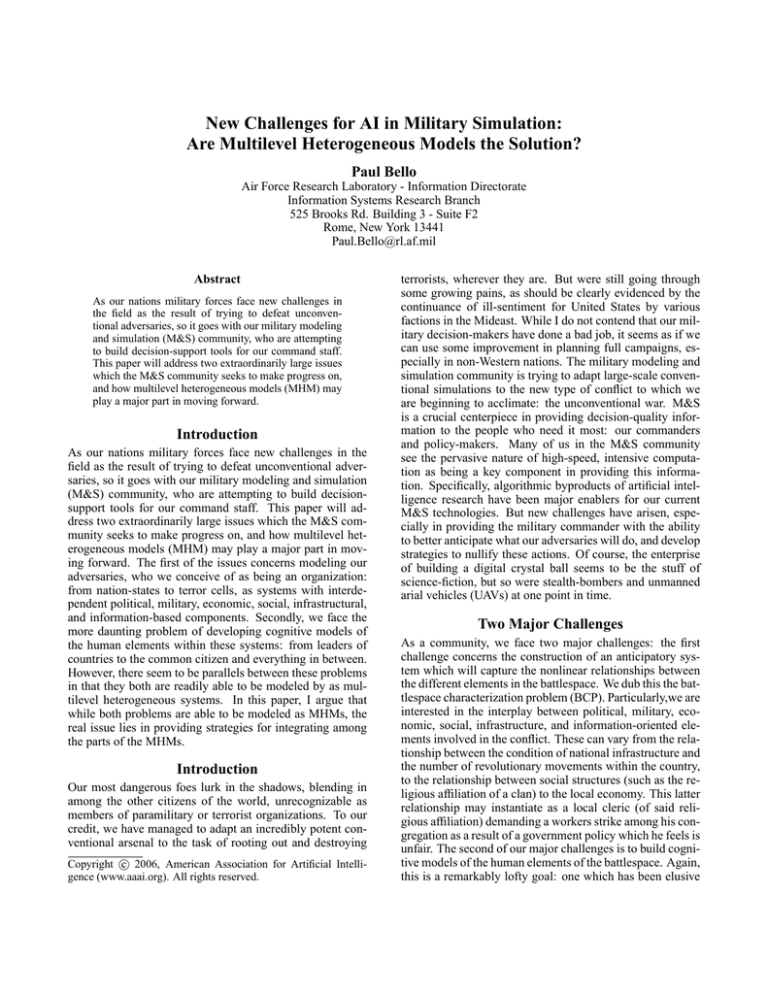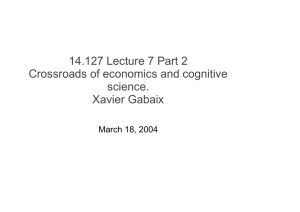
New Challenges for AI in Military Simulation:
Are Multilevel Heterogeneous Models the Solution?
Paul Bello
Air Force Research Laboratory - Information Directorate
Information Systems Research Branch
525 Brooks Rd. Building 3 - Suite F2
Rome, New York 13441
Paul.Bello@rl.af.mil
Abstract
As our nations military forces face new challenges in
the field as the result of trying to defeat unconventional adversaries, so it goes with our military modeling
and simulation (M&S) community, who are attempting
to build decision-support tools for our command staff.
This paper will address two extraordinarily large issues
which the M&S community seeks to make progress on,
and how multilevel heterogeneous models (MHM) may
play a major part in moving forward.
Introduction
As our nations military forces face new challenges in the
field as the result of trying to defeat unconventional adversaries, so it goes with our military modeling and simulation
(M&S) community, who are attempting to build decisionsupport tools for our command staff. This paper will address two extraordinarily large issues which the M&S community seeks to make progress on, and how multilevel heterogeneous models (MHM) may play a major part in moving forward. The first of the issues concerns modeling our
adversaries, who we conceive of as being an organization:
from nation-states to terror cells, as systems with interdependent political, military, economic, social, infrastructural,
and information-based components. Secondly, we face the
more daunting problem of developing cognitive models of
the human elements within these systems: from leaders of
countries to the common citizen and everything in between.
However, there seem to be parallels between these problems
in that they both are readily able to be modeled by as multilevel heterogeneous systems. In this paper, I argue that
while both problems are able to be modeled as MHMs, the
real issue lies in providing strategies for integrating among
the parts of the MHMs.
Introduction
Our most dangerous foes lurk in the shadows, blending in
among the other citizens of the world, unrecognizable as
members of paramilitary or terrorist organizations. To our
credit, we have managed to adapt an incredibly potent conventional arsenal to the task of rooting out and destroying
c 2006, American Association for Artificial IntelliCopyright gence (www.aaai.org). All rights reserved.
terrorists, wherever they are. But were still going through
some growing pains, as should be clearly evidenced by the
continuance of ill-sentiment for United States by various
factions in the Mideast. While I do not contend that our military decision-makers have done a bad job, it seems as if we
can use some improvement in planning full campaigns, especially in non-Western nations. The military modeling and
simulation community is trying to adapt large-scale conventional simulations to the new type of conflict to which we
are beginning to acclimate: the unconventional war. M&S
is a crucial centerpiece in providing decision-quality information to the people who need it most: our commanders
and policy-makers. Many of us in the M&S community
see the pervasive nature of high-speed, intensive computation as being a key component in providing this information. Specifically, algorithmic byproducts of artificial intelligence research have been major enablers for our current
M&S technologies. But new challenges have arisen, especially in providing the military commander with the ability
to better anticipate what our adversaries will do, and develop
strategies to nullify these actions. Of course, the enterprise
of building a digital crystal ball seems to be the stuff of
science-fiction, but so were stealth-bombers and unmanned
arial vehicles (UAVs) at one point in time.
Two Major Challenges
As a community, we face two major challenges: the first
challenge concerns the construction of an anticipatory system which will capture the nonlinear relationships between
the different elements in the battlespace. We dub this the battlespace characterization problem (BCP). Particularly,we are
interested in the interplay between political, military, economic, social, infrastructure, and information-oriented elements involved in the conflict. These can vary from the relationship between the condition of national infrastructure and
the number of revolutionary movements within the country,
to the relationship between social structures (such as the religious affiliation of a clan) to the local economy. This latter
relationship may instantiate as a local cleric (of said religious affiliation) demanding a workers strike among his congregation as a result of a government policy which he feels is
unfair. The second of our major challenges is to build cognitive models of the human elements of the battlespace. Again,
this is a remarkably lofty goal: one which has been elusive
since the inception of both AI and cognitive science as academic fields. I am not under the impression that any of us in
the military M&S community are expecting a solution any
time in the near future, but we are hoping at the minimum to
isolate and analyze some of the more difficult aspects of the
problem in light of both hardware, software, and theoretical
advances. The problem of developing computational cognitive models capable of achieving human-level intelligence
(at least in a somewhat rich domain) is the perfect opportunity for a renewed dialogue between AI researchers and
cognitive scientists. I propose that multilevel heterogeneous
models can be utilized in making progress on both of these
daunting challenges, particularly in the development of cognitive models of multi-agent systems (CMMAS) which will
be used to implement both single and multi-agent systems of
human actors with an eye to fidelity of behavior. I view each
challenge as an instance of an integration problem between
system elements (either battlespace elements or specifically
human elements) at a number of levels of abstraction (multilevel) and over a number of different representations (heterogeneity). The multilevel integration problem is endemic
to the multi-agent systems community, often dubbed the
“micro-macro” problem, and bidirectionally relates the behavior of atomic elements (individual agents) with aggregate
elements (such as organizations, groups, cultures, societies,
et cetera). In the battlespace characterization problem, the
multilevel problem appears not only in differentiating individual human elements from groups, but also in relating the
behavior of gubernatorial powers from the village-level to
the national-level, or regional microeconomics to national
macroeconomics among others. The heterogeneity problem
arises in both challenges as well. In the case of the BCP, information regarding the political, military, economic, social,
infrastructure, and informational (PMESII for short) aspects
of the battlespace cannot usually be captured using a homogeneous computational representation (numbers or symbols)
or dealt with in a methodologically pure way (a completely
logic-based, or Bayesian solution, for example). Usually,
each modeler develops his/her characterization of some aspect of the battlespace in a formalism of choice. How do
we get all of these models, operating over multiple representations and using multiple computational methodologies
to talk to one another? The heterogeneity problem also expresses itself at the level of developing CMMAS. Even at
the level of developing computational cognitive models of
single agents, the heterogeneity problem arises. For example, one of the dominant themes in Ron Suns CLARION
architecture (Sun 2001) involves capturing the distinction
between implicit and explicit learning processes. Implicit
knowledge is usually characterized as distributed, not consciously accessible, and therefore unable to be verbalized;
whereas explicit knowledge is has a localist representation,
is consciously accessible, and therefore able to be verbalized. How do implicit and explicit learning processes interact with one another? This is a classic case of heterogeneity
in the human cognitive architecture. Both CMMAS and the
BCP are facing the same conundrum: they are both naturally
modeled as multilevel heterogeneous systems, yet both face
a serious problem of integration.
Integrating MHM’s
As we have seen, both battlespaces can be roughly thought
of as an extremely complex multilevel heterogeneous model.
As of today, PMESII modeling is diffuse, with various experts developing proprietary models. In many cases, each
type of information can be expressed compactly using multiple representations and different computational methodologies. Local laws (part of the political aspect of the BCP)
may be best modeled using (defeasible) rule-based systems,
whereas a neural network may be convenient for capturing
financial dynamics due to oil exports (part of the economic
aspect of BCP). It seems strikingly clear that political institutions (such as trade laws) may have a startling impact on
oil exports, and thus the financial dynamics of the country
which in turn may effect voter attitudes, and thus the fate
of politicians. Recently, AFRL has embarked on a program
to define both environments for developing PMESII models,
and reasoning engines allowing these models to effectively
communicate with one another. One promising approach
has been offered in (Cassimatis 2005). The Polyscheme architecture was developed to reason across multiple representations in service of providing models of an infants reasoning about its physical environment. The claim is that infants
use object recognition (implemented as neural networks),
simple rule-based reasoning and temporal constraints (just to
name a few) in a highly integrated ensemble in order to make
inferences about their physical environs. Recently, it has
also been used to develop computational cognitive models
of “theory-of-mind” (ToM) mechanisms in children (Bello
& Cassimatis submitted). ToM allows humans to predict
and explain the behavior of other agents by appealing to the
mental states of other agents: especially beliefs, desires, and
intentions (Flavell, Miller, & Miller 2001). The Air Force
Research Laboratory will be using the Polyscheme architecture to begin making progress on developing environments
for PMESII modeling, and a reasoning engine with which
to make inferences about the various PMESII effects associated with taking certain kinds of actions in a simulated battlespace. Polyscheme is a promising example of the kinds
of integration engines needed to make progress on problems
like the BCP and CMMAS: inspired by principles in cognitive science yet replete with the rich representational formalisms found in AI research; and thus a perfect opportunity
for synergy between the two disciplines.
References
Bello, P., and Cassimatis, N. (submitted). Some unifying
principles for computational models of theory-of-mind. In
Proceedings of the 2006 International Conference on Cognitive Modeling.
Cassimatis, N. 2005. Integrating cognitive models based
on different computational methods. In Proceedings of the
27th Annual Meeting of the Cognitive Science Society.
Flavell, J.; Miller, P.; and Miller, S. 2001. Cognitive Development. Prentice Hall.
Sun, R. 2001. The Duality of the Mind. Lawrence Erlbaum
Associates.





